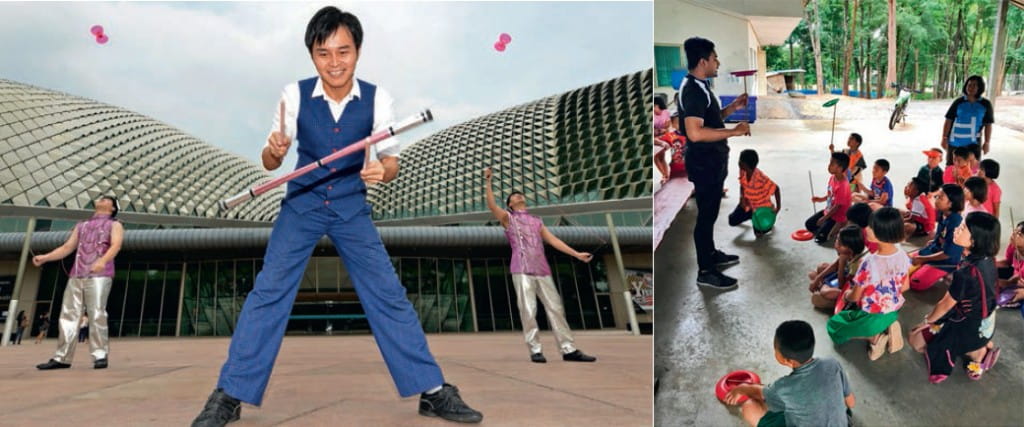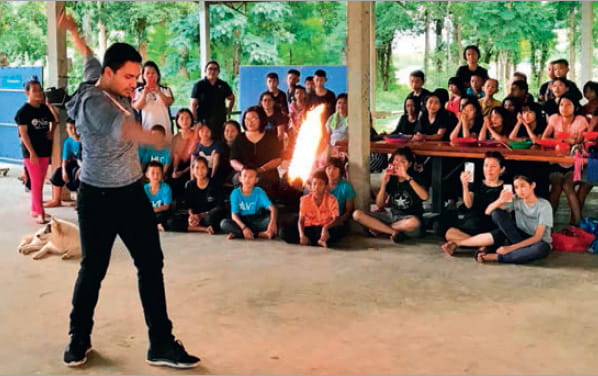Stories > Editor's Note
Perspective
Clowning around to build skills and confidence? Circus in Motion helps empower youths at risk in Singapore and Asia.
BY ALYWIN CHEW
s its name suggests, Circus In Motion is a company that puts up live shows with costumed performers executing a variety of stunts, such as stilt walking, juggling and twirling fiery batons.
But what sets this company apart from typical circus troupes is that it does not simply set out to entertain audiences.
With the aim of preventing youths at risk from developing behavioural problems, the troupe guides them through a 12-week training stint whereby they are taught circus acts. At the end of the programme, their newfound skills take centre stage in a showcase, be it a school concert or a jam session, with other trainees at Circus In Motion’s studio.
This unique approach to reform, says its founder, Jay Che, helps to channel teenagers’ energy in a positive direction, as opposed to repressing it through harsh disciplinary measures.
“Youths generally like to take risks. At Circus In Motion, we teach them how to do just that, but in a positive manner. Here, we get them to focus on mastering acts such as walking on a tight rope or twirling fire, instead of shoplifting or committing other misdemeanours,” explains Che.
“The beauty of learning circus acts is that the playing field is level. Everyone starts at the same point, and you can only forge ahead and become more skilful by training hard. And it is through this learning process that trainees discover themselves.”
CIRCUS WITH CONSCIENCE
A trained social worker and counsellor, Che developed a desire to help others better themselves in his formative years, when he witnessed several of his football teammates succumb to the habit of glue-sniffing, and his neighbour being arrested for suspected drug abuse. Determined to help at-risk communities like the one he grew up in, he decided to study social work at the National University of Singapore (NUS).
It was in 2001, his final year of studies, that the undergraduate came to learn about social circus, a movement that uses circus arts as mediums for social good.
While doing his internship at Tampines Family Service Centre, he took part in a workshop conducted in collaboration with Cirque du Monde, the social arm of renowned circus troupe Cirque du Soleil. Che was immediately intrigued by what he learnt there, which included the concept of increasing self-awareness and discipline while promoting individuality through circus training.
After graduating from NUS, he spent three years as a social worker for Tampines Family Service Centre. During this time, he also attended three week-long training sessions with Cirque du Monde in Melbourne, where he learnt about the different strategies involved in managing youths at risk. In 2006, he set out to start his own social circus troupe. But this did not immediately take off.
“It was tough at the beginning. The concept of social circus was still novel back then, and many of the schools I approached to get their students to enrol in my programme rejected my idea. There was a lot of convincing to do,” he shares.
“The Beauty Of Learning Circus Acts Is That The Playing Field Is Level. Everyone Starts At The Same Point, And You Can Only Forge Ahead And Become More Skillful By Training Hard.”
Jay Che, Founder Of Circus In Motion
To stay afloat financially, Che performed at private events. But he never stopped knocking on doors to promote social circus as an effective means of intervention for troubled youths. School administrators soon started to warm to his pitches. Even his father, who had initially disapproved of his unusual career choice, jumped on board by helping him craft some of the circus props.
Within a few years, Circus In Motion was performing at a variety of high-profile events such as the Youth Olympic Games, the WTA Tour in Singapore and the DBS Marina Regatta. Meanwhile, the number of schools that engaged its services also grew.
In 2013, Circus In Motion was nominated for the President’s Challenge Social Enterprise Award. Under the Ministry of Education’s Time-Out programme, which aims to reduce the dropout rate of students at risk, it now conducts circus workshops at secondary schools around Singapore. That, on top of holding workshops for children with special needs, occupy the bulk of its time.
Today, the troupe has three other full-time instructors and a pool of 12 freelancers, all of whom once trained there as troubled students. One of them is Benjamin Teo, who first encountered Circus In Motion more than a decade ago, when he was sent for the social circus programme held at his school.
“I was just fascinated with the acts. They seemed impossible when I first saw them. But I soon learnt that with enough practice, they were definitely doable,” says Teo, who used to get into trouble for vandalism and shoplifting.

Founder Jay Che was motivated to help others better themselves when, as a boy, he witnessed his peers succumbing to substance abuse; Circus in Motion has conducted overseas outreach programmes in rural areas around the region.
“The programme helped me to set targets in life. The journey will certainly be tough, but if one keeps trying, it will surely be completed,” he explains.
Under Che’s guidance, Teo performed better at school, and even obtained a degree in social work, like his mentor. Once at the receiving end of the programme, Teo is now a full-time instructor with Circus in Motion, helping other youths at risk on the school’s outreach programmes.
Teaching at-risk youths how to play with props as part of an intervention might seem counter-intuitive, but the fact that Circus In Motion has helped some 9,000 people in Singapore and abroad since its inception suggests otherwise.
“Circus In Motion Has Conducted More Than 20 Outreach Programmes Around South-east Asia. Being Exposed To The Customs, Songs And Festive Foods Of International Youths Has Made The Experience Rewarding.”
ALL THE WORLD’S A STAGE
Apart from staging shows in Singapore, the troupe also performed in Incheon, South Korea in 2014 as part of the International Clown Mime Festival by South Korean arts entertainment company Small Theatre Dolce. Working with the Koreans, Che says, gave the troupe insights into a culture of which they previously lacked an understanding.
“We learnt that hierarchy is a big part of Korean culture. The Koreans have a practice of toasting the more senior or higher-ranked members of their group first, which we discovered through our interactions,” he shares.
|
Youths at risk who attend Circus in Motion's training sessions learn fire twirling, balancing skills and other circus acts. |
And though they had to grapple with language barriers, the teams managed to successfully stage the show with the help of an interpreter. Through the process of collaborating, Che says that their foreign counterparts became accustomed to the Singaporeans’ high regard for punctuality. Performing abroad as a troupe has been a one-off event due to funding issues, but Circus in Motion has conducted more than 20 outreach programmes in countries like Thailand, Malaysia, Cambodia and Indonesia. These overseas trips have been eye-opening for Che, who says that being exposed to the customs, songs and festive foods of international youths has made the experience all the more rewarding. |
Though they did not speak the same language, Che insists that he did not face any challenges working with them, citing their eagerness to learn as an asset.
“Last year, we conducted our social circus programme for the Hmong people, who live as refugees in central Thailand. It typically takes at least 13 sessions for people to learn fire twirling, but this 14-year-old Hmong girl did it in just six or seven sessions. It was amazing,” he says.
“Sometimes I feel such youths from less-affluent countries are a lot more motivated to gain knowledge and skills.”
Working with youths from a diversity of communities has inspired Che and his troupe in more ways than one. In Battambang, Cambodia, for instance, they were impressed by the ingenuity of the locals, who were able to infuse the performances with their culture.
“We saw how they incorporated Khmer music into the show, and juggled fisherman’s hats, as fishing is integral to their livelihoods. All this spurred us on to find our own identity, leading to the creation of an act involving tikam tikam, an old-school Singaporean game,” he shares.
The future looks bright for this circus troupe, and Che has plans to open a full-fledged circus school in Singapore. But for now, he is continuing to change lives one act at a time.

